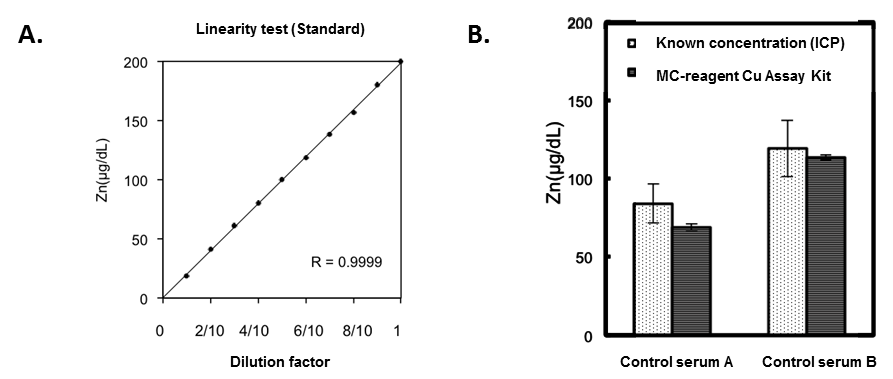
This assay shows, A) good linearity for full assay range and B) good correlation with ICP (known concentration).
Zinc Colorimetric Assay Kit (5-Br-PAPS Method)
JAI-CZN-001
Product group Chemicals
Overview
- SupplierJaICA
- Product NameZinc Colorimetric Assay Kit (5-Br-PAPS Method)
- Delivery Days Customer10
- CertificationResearch Use Only
- Scientific DescriptionThis MC-Reagent Zinc Assay Kit is a direct colorimetric assay based on the 5-Br-PAPS method without deproteinization of the sample. The zinc determination is based on the reaction of zinc with 5-Br-PAPS at alkaline pH in a buffered media, which forms a stable colored complex. The color intensity is proportional to the zinc concentration in the sample. Absorbance of the Zn2+-complex is measured at 560nm. Wavelength range of sensitivity: 550 ~ 580nm. Features of this Assay: Quick & Easy to use Species independent Highly sensitive, stable and suitable for high-throughput testing No toxic substances For cell lysates, serum, plasma and wide variety of biological samples - Zinc (Zn2+) is an essential trace element, vital for the health of animals, plants, and microorganisms . Zinc is found in hundreds of enzymes, is stored and transferred in metallothioneins, and serves as structural ions in transcription factors. Zinc is often coordinated to the sides chains of amino acids, such as aspartic acid, glutamic acid, histidine and cysteine and is involved in nucleid acid and protein synthesis. It is therefore a necessary complement for cell replication. In humans, zinc interacts with a variety of organic ligands, and has roles in nucleic acid metabolism, apoptosis, neurological development, signal transduction, and gene expression. Zinc deficiency is related to skin lesions, irritability, loss of hair, growth retardation and impaired immunological functions.
- Storage Instruction2°C to 8°C
- UNSPSC12352200
